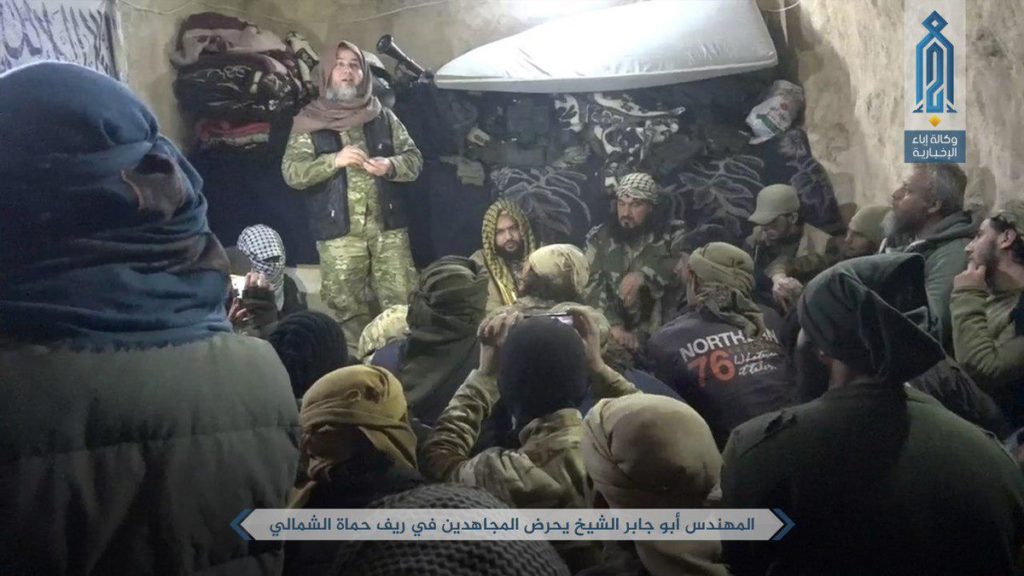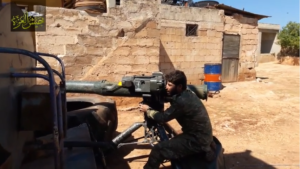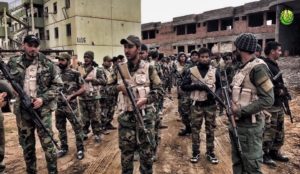Analysis: Insurgents launch major offensive against Assad regime in Hama province
By
Thomas Joscelyn | March 24, 2017 |
[email protected] |
@thomasjoscelyn
Insurgent organizations — including jihadists, Islamists and rebel groups affiliated with the Free Syrian Army (FSA) — launched a large-scale offensive against Bashar al Assad’s regime in Hama province earlier this week. The battle began on Mar. 21, when the insurgents assaulted more than a dozen towns and villages north of the city of Hama.
Hay’at Tahrir al Sham (HTS),
al Qaeda’s joint venture in Syria, has produced a stream of content from the offensive. One of the first HTS images posted online showed the group’s leader, a jihadist known as
Abu Jaber, rallying his fighters. Sitting to his left was
Sheikh Abdullah al Muhaysini, a
US-designated terrorist who is a senior HTS sharia official and likely a major figure in al Qaeda’s international network. The photo of Abu Jaber and Muhaysini can be seen at the top of this article.
HTS dispatched suicide bombers in vehicle-borne improvised explosive devices (VBIEDs) during the early hours of the fighting.
One of them, identified as a foreign fighter, drove his explosive-laden vehicle into a military checkpoint outside the town of Suran, which is close to the city of Hama. HTS used a small drone to record footage of the operation, dramatizing the suicide bomber’s approach to the checkpoint and the moment of his impact. A second suicide bomber followed, hitting another regime-controlled facility. The jihadists claim to have captured Suran not long after. Another HTS suicide bomber, a Syrian, was dispatched in the nearby town of Maardes. And still others struck elsewhere, including in the towns of Maardes and Qamhana, where a
large, fully armored VBIED was employed.
The suicide bombers paved the way for HTS’ “special forces” to rush in. In the days leading up to the Hama operation, HTS advertised its highly-trained, elite guerrilla fighters in a video and photos. While they are not the caliber of Western special forces, these jihadists have received extensive training on small arms and insurgent tactics, making them far more effective than the average rebel fighter. The “special forces” includes “inghimasis,” who “immerse” themselves in battle and are usually willing to commit at suicide attack after advancing on their enemies. HTS has used inghimasis in several operations elsewhere in recent weeks,
including in Homs.
On Mar. 23, HTS released a summary of the first part of the battle, claiming that more than a dozen towns, villages and other points had fallen to the insurgents. HTS promoted not only its own advances, but also mentioned that other organizations (branded as Free Syrian Army rebels) had simultaneously advanced nearby. The FSA-affiliated rebels are discussed more below.
The HTS statement (seen on the right) is
similar to the types of reports usually issued by the Islamic State, which is al Qaeda’s main jihadist rival. It appears that HTS’ propagandists took a page out of the so-called caliphate’s book and decided that such summaries are useful for advertising their operations.
The HTS reports and other propaganda were produced by the newly launched Ebaa News Agency. Al Qaeda’s branch, first known as Al Nusrah Front and then as Jabhat Fath al Sham, is the main constituent in HTS. Al Nusrah had a “correspondents network” that produced content from throughout all of Syria. Ebaa is the descendant of Al Nusrah’s propaganda arm, only with new branding and updated techniques.
Via Ebaa, HTS has issued separate messages claiming control over several towns. The jihadists have used tanks, including T-90s, in the contested locales. In one video, an armored convoy is shown advancing into Qamhana. Ebaa has also posted photos of
identification cards allegedly belonging to deceased fighters who were loyal to the Assad regime.
The al Qaeda-affiliated Turkistan Islamic Party (TIP)
announced its role in the offensive on a new Twitter feed. The TIP, which is comprised mainly of Uighur jihadists, has since claimed the capture of “
several points” as well. It is possible that other ethnic al Qaeda units, such as Chechen or Uzbek jihadists, are on the ground in Hama.
Ahrar al Sham, which has long been allied with al Qaeda’s Syrian branch, apparently didn’t join the fight at first. But Ahrar’s military spokesman, Omar Khattab, subsequently
announced on Twitter that his men had entered the fray. Differences between HTS and Ahrar al Sham emerged in recent months, with the two reportedly skirmishing in Idlib. It appears that Ahrar may have entered the battle as part of a separate operations room, but Ahrar and HTS have also fought side-by-side in southern Syria in recent weeks.
Sources friendly to the Assad regime have claimed that some of the towns and villages were recaptured. That is possible. However, there is an ebb and flow to the fighting, making it difficult to determine from afar which party has the upper hand at any given time. Regardless, the fighting in northern Hama continues.
Free Syrian Army-branded groups fighting in northern Hama
Perhaps as many as ten or more groups that are part of the loosely configured Free Syrian Army (FSA) are engaged in the heavy fighting in Hama.
Jaysh al Ezzah (Al Ezzah Army),
Jaysh al Nasar, the
Free Idlib Army, the
Authenticity and Development Front,
Al Nokhba Army, the
Safwa Division, the
Central Division, and
Abna al Sham,
among others, have all produced media from the northern Hama offensive.
Jaysh al Ezzah has been among the most prolific of these organizations to produce videos, photos and statements. Some of its media records the use of American-made, antitank TOW missiles. Jaysh al Ezzah has used several TOWs — including against the regime’s tanks and artillery pieces — in northern Hama since the fighting began. A screen shot from a Jaysh al Ezzah video of one of its fighters using a TOW to debilitate a T-72 tank can be seen on the right. The organization is also
using drones to record footage from overhead.
Jaysh al Nasar says that its men have launched Grad rockets at the Hama military airport. At least two photos document the Grad launches off the back of trucks.
Earlier today, a statement bearing Jaysh al Nasar’s logo
was released in an attempt to reassure residents in Hama that the FSA has no sectarian agenda and is solely focused on defeating the Assad regime. The message was translated by @FSAPlatform, a Twitter feed that tracks FSA-branded rebels. Jaysh al Nasar says the battle for northern Hama is part of the “revolution” to overthrow Assad and then hold his regime accountable for the “crimes committed against civilians.” The organization says it will abide by all “international treaties and conventions related to human rights,” explaining that “this operation is not against any sect, race or religion.”

The Free Idlib Army has attacked the regime-controlled Zayn Al Abdeen Mountain with rockets, according to its propaganda. The mountain lies south of positions targeted in the first two days of the operation, and it is just one area under assault by the Free Idlib Army’s forces. The FSA-affiliated fighters have produced several maps, similar to those used by HTS, to document the rebels’ advances. One of the Free Idlib Army’s maps can be seen on the right.
The Safwa Division is fighting north of the Zayn al Abdeen Mountain, judging by the photos released on its Twitter feed. One
image documents the Assad regime patch on a fighter who was killed in the area. Another
picture purportedly shows one of Safwa’s fighters near the mountain.
Meanwhile, short videos
tweeted by the Central Division record anti-aircraft fire aimed at Assad’s war planes flying in Hama’s skies.
Still other rebels are likely involved. It is often difficult to track the FSA-affiliated groups, as they do not appear to have a uniform chain of command and the specific FSA units involved in Syria’s battles vary by geographic location. It is also probable that the FSA organizations mentioned here do not all adhere to the same ideology, with some being Islamist.





